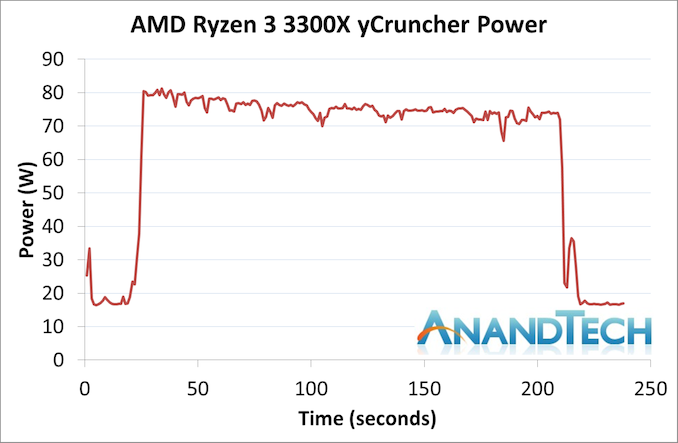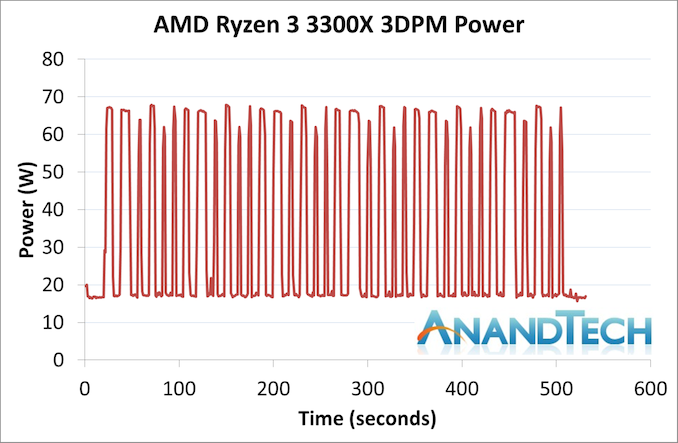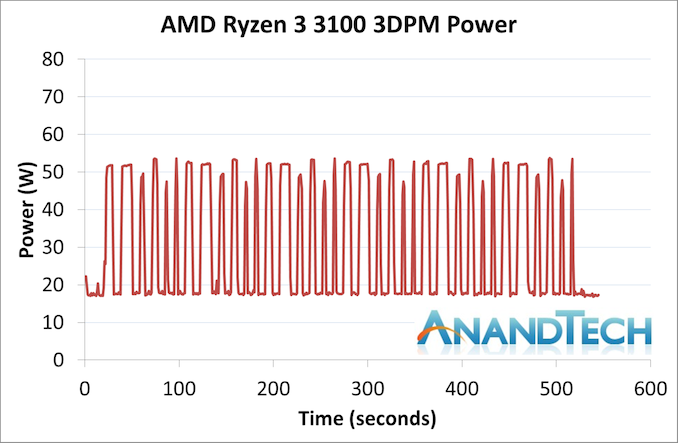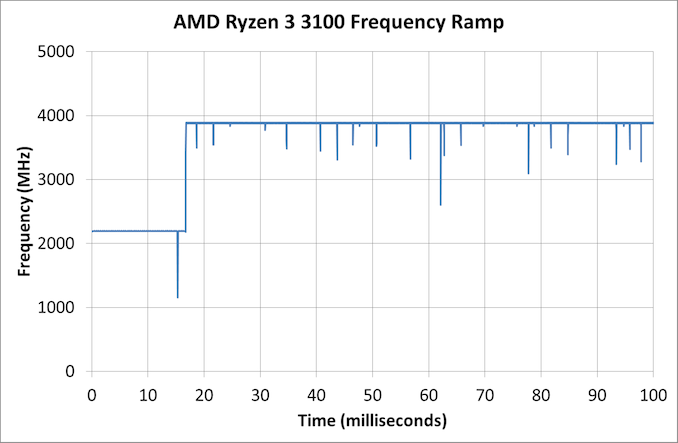The AMD Ryzen 3 3300X and 3100 CPU Review: A Budget Gaming Bonanza
by Dr. Ian Cutress on May 7, 2020 9:00 AM ESTPower Consumption and Frequency Ramps
On the box, both processors are listed as having 65 W TDPs. With its Zen-based hardware, AMD has been relatively good at staying around that official on-the-box value, even during turbo. In the last generation, AMD introduced a feature called PPT, or Package Power Tracking.
- For 105 W processors, PPT is >142 W
- For 65 W processors, PPT is >88 W
- For 45 W processors, PPT is >60W
This allows the processor to raise its power limits, assuming it isn’t breaching thermal limits or current limits, and consequently raise the frequency. As a result, while we see 65 W on the box, the real world power consumption during most tasks is likely to be nearer 88 W, unless the current or thermal lines are crossed.
As a new element to our testing, we are recording power over a number of benchmarks in our suite, rather than just a simple peak power test.
AMD Ryzen 3 3300X
For the faster chip, we saw a peak power in both of our tests of around 80 W.
With yCruncher, which is somewhat of a periodic load, the power consumption dropped over time to nearer 75 W.
3DPM is more obvious with its idle steps between loads, being 10 seconds on then 10 seconds waiting. The power almost peaked at a similar amount here.
In both of these graphs, the package power when idle is around 16-17 W. I looked back through the data, and noticed that out of this power only 0.3 W was actually dedicated to cores, with the rest being towards the big IO die, the memory controllers, and the Infinity Fabric. That’s still pretty substantial for an idle load.
At low loads, the power per core was around 14 W, while at full load it was slightly less depending on the test. This is a bit away from the 20 W per core we get from the high end Zen 2 processors, but these only go to 4.3 GHz, not 4.7 GHz+. This is about in line with what we expect.
On our frequency ramp test, the Ryzen 3300X went from an idle state to peak power within 17 milliseconds, or approximately a frame at 60 Hz.
One of the new features with Ryzen 3000 is CPPC2 support, which AMD claims to reduce idle-to-turbo ramping from 30 milliseconds to 2 milliseconds. We’re seeing something in the middle of that, despite having all the updates applied. That being said, the jump up to the peak frequency (we measured 4350 MHz, +50 MHz over the turbo on the box) is effectively immediate with zero skew across a range of frequencies.
AMD Ryzen 3 3100
Given that the TDP number on the side of the box says 65 W as well, any reasonable user would assume that the power of this chip would be equal, right? Regular readers will know that this isn’t always the case.
In our yCruncher test, because the turbo frequency is lower than the 3300X, it means the voltage can be lower, and thus power is lower. Our history of testing Zen 2 has shown that these cores get very efficient at lower frequencies, to the point where our processor doesn’t even break that 65 W threshold during yCruncher.
Similarly the 3DPM peaks are also lower, barely going to 55 W during an AVX2 workload.
On the frequency ramp side, we see another instance of a 16-17 ms transition.
Summary
For the peak power out of all of our testing, we saw the Ryzen 3 3300X hit a maximum of 80 W, and the Ryzen 3 3100 go to 62 W. When we compare that to the Core i7-7700K, at 91 W TDP / 95 W peak, combined with most of the results on the next few pages, AMD by comparison is more efficient.
















249 Comments
View All Comments
Spunjji - Monday, May 11, 2020 - link
The issue is that it's not informed. It's codswallop.PeterCollier - Monday, May 11, 2020 - link
You're talking about the article.Spunjji - Tuesday, May 12, 2020 - link
🤡psychobriggsy - Thursday, May 7, 2020 - link
Considering it shows the $120 AMD offering comprehensively beating the old i7-7700K, and says the current Intel budget offerings will be slower, and recommends the AMD processors, I find this comment rather brain dead.WaltC - Thursday, May 7, 2020 - link
One question I had is why AT chose to use the 2600 instead of the 3600...? Makes no sense to me, as the 3600 runs at 65W and the 3600X runs at 95W--just like the 2600--only the 3600 is appreciably faster--but costs the same! 3600 is MIA. No question but that the review benchmarks clearly demonstrate the superiority of the AMD offerings, but we already knew that. I see the omission here--deliberate--of the 3600--while including $425 Intel 6c/12t offerings--as surely an apology for Intel's inability to compete. Such is not needed, really. Apologizing in subtle ways for Intel is, I think, a pretty poor way to write a review on CPUs Intel cannot at the present time compete with--the 3100/3300. Getting right down to it--there was no need to include *any* 6c/12t CPUs here, right? Should have been comparisons only with Intel/AMD 4c/8t cpus, exclusively, imo. Selection of CPUS for *this review* didn't make any objective sense that I could see--beyond the obvious, of course (at least you didn't forget and leave the 3100/3300 out...;))evilspoons - Thursday, May 7, 2020 - link
I'm guessing the omission of the 3600X has something to do with, at the time I read this, they hadn't even finished all the benchmarks for the 3100. You know, the one in the headline. I don't think it's a conspiracy, just a time constraint.crimson117 - Thursday, May 7, 2020 - link
They didn't rerun the 2600 for this, they used existing benchmarks.They haven't ever benchmarked the 3600 previously, so it's not listed here. They do have the 3700X, however, which is essentially the same performance as a 3600 (except in heavily threaded workloads): https://www.anandtech.com/bench/product/2520?vs=25...
MDD1963 - Thursday, May 7, 2020 - link
I saw other testers on Youtube use the 3600, and, the 3300X was VERY surprisingly close to it's performance...; the 3300X's clearly quite strong threads and lack of inter -CCX -RAM latency issues are reaping benefits!BenSkywalker - Thursday, May 7, 2020 - link
The choices they use to compare are utterly bizarre. A three and a half year old Intel i7 and last generation Ryzen parts....?Legitimately, this review is useless if you are shopping *today*, not just from a team red versus team blue, but where this processor sits in today's market, no clue after reading this. One of my friends was looking for a budget gaming build and I was looking at a 3200G/B450 setup, how does this compare? Instead let's assume people have a time machine and are cross shopping two gen old Ryzen and three green old Intel parts....?
The charts aren't bad, they are terrible. Have an old i7 in there for reference, ok, put current Ryzen 3 and i3 inn there and if you don't have enough time *only* include them.
rabidpeach - Friday, May 8, 2020 - link
bro, they try to make a point with the reviews. if you want this comparison you use the cpubench feature of this website and compare any chip they tested on any of the tests they have. it's an actual feature not a bug. the point of this article and tests is to show entry level amd 100 price point is as powerful as 3 year old flagship-ish intel for the mainstream. it shows against the zen and zen+ hexacores that it catches up to them in many situations despite lacking in cores. this shows you amd is not just throwing cores at intel anymore. they have ipc too! ok any more spoon-feeding? would you prefer a spork?